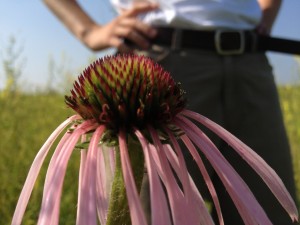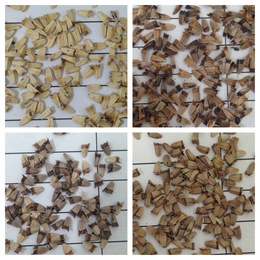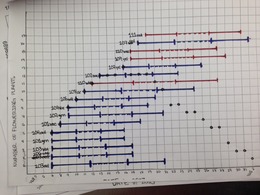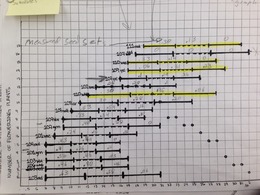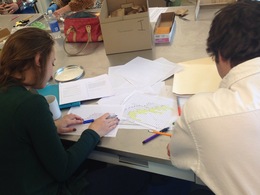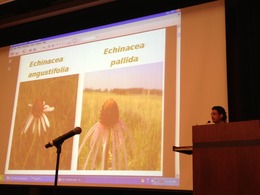|
|
In 2015, we continued an experiment that investigates hybridization between the native Echinacea angustifolia and the unintentionally planted non-native E. pallida. This year, out the the 758 plants planted in spring 2014, 521 were still alive which is a survival rate of 68.7%.
In the late summer of 2013, members of Team Echinacea collected heads from Echinacea angustifolia and Echinacea pallida from two nearby populations at Hegg Lake Wildlife Management Area. Unlike previous experiments, we performed no artificial crosses. This allows us to determine if hybridization is occurring naturally. In the winter of 2014, Lydia English germinated seeds from these heads. In the spring, Lydia and Stuart planted 758 seedlings at Hegg Lake WMA near experimental plot 7. We took fitness measurements, such as number of rosettes and leaf lengths, this year.
In addition to the experimental plot, we collected heads and tissue samples from 28 E. angustifolia that were near the restoration with E. pallida. We have not yet done any analysis on these plants but we are hoping to determine if hybridization in continuing.
Read more posts about this experiment here.
 Echinacea Pallida at Hegg Lake Start year: 2014
Location: Hegg Lake Wildlife Management Area – Experimental plot 9
Davis Blasini was awarded the best undergraduate student poster in 2014 by the Ecology Section of the Botanical Society of America: “Introduction of Echinacea pallida in the Prairies of Western Minnesota and its Possible Effects on Native Echinacea angustifolia” Co-author: Stuart Wagenius.
Congratulations, Davis!
Today was a great day for Team Echinacea! After a quick morning of remnant phenology, we finished measuring Lydia’s Experimental Plot 09!!! On the Northwest Phenology Route, all flowering Echinacea at East Elk Lake Road and North West of Landfill have finished flowering. It is pretty cool to think of how long we have been returning to these sites for phenology, and now many of them are wrapping up (and quickly!). In the afternoon Elizabeth, Gretel, Jared and I were busy working on demography at East Riley, Riley, Railroad Crossing, and North of Railroad Crossing. Other team members went to KJ’s to look for seedlings that teams have been following in years past.
On the pollinator note comes a follow up from Steve Ellis’s talk with us last Friday. I recently came to learn that the city of Shorewood, MN has passed a law banning the use of neonicotinoids!!!! Shorewood now joins the all too small list of cities banning neonics, including Eugene, Oregon and Spokane, Washington. Although this is a small step towards protecting the bees, Shorewood has made a very important statement. Check out the Star Tribune article about the recent ban, along with a post on the Beyond Pesticides Daily News Blog!
http://www.startribune.com/local/west/269627281.html
We had a very quick and efficient planting last week. Stuart and I drove up to MN on Thursday morning, picking up Katherine Muller on the way in St. Paul. We arrived in Kensington on Thursday evening, and immediately got to work. We broadcasted our remaining little bluestem and side oats gramma grass seeds in the South Field (where we planted our qGen2 achenes this fall, aka CG-8). We walked E/W throughout the plot and each broadcast seed over a 5m area. We also broadcast seed around the edge of the plot. Here’s an inventory of how much we broadcast from each of the collection sites:
Peninsula – 1 quart
Back Hill – 1 quart
LCW – 2 quarts
CR-15 – 1 quart
Tower – 1 quart
Krus – 1 quart
RRX- 1 oz
CG1 – 1 gallon (24 Sept) + 1 gallon (30 Sept) + 2.5 gallons (2 Oct).
We then headed to Hegg Lake to scout out a planting site for the sprouts. We settled on a spot near the parking area, to the west of Amy’s, Caroline’s, and the recruitment plots. The plot is 12m x 30 m with 13 rows and 60 positions. There is a meter spacing between rows and half a meter between positions.
We returned the next morning and began planting by 9:30am. With three of us we were very efficient and finished our last row by 3:30pm. We we lucky to have beautiful weather, it was sunny all day with temperatures in the low-mid 70s and a consistently strong breeze. All positions in the plot were plant-able. Here’s a diagram of the plot:

Empty circles indicate positions where a sprout was planted and black dots indicate positions where there are nails. Plants begin at position 0.5 in every row. Row 41 is the most western row, and position 0 is closest to the road (and north). There are empty positions at the ends of rows 46 and 48. There is a bent over flag at each of the 4 corners of the plot.
I’m excited to have the sprouts in the ground and to have participated in my first planting. Fingers crossed we have high survival!
We like to tell anyone that volunteers or works in the lab that Echinacea achenes come in all shapes and sizes. Here’s an example:

Now if you can’t already tell, these are not the achenes you may be used to seeing. These are all achenes from Echinacea pallida, a purple cone flower species not native to Minnesota but planted in some restorations within our field site. These specific achenes come from Hegg Lake, and they are some of the same achenes that Grace and Aaron, our interns from December, weighed and x-rayed in their analysis modeling hybridization between E. angustifolia and E. pallida. We are going to germinate and grow up some of these plants to see if hybridization is occurring in nature. Nicolas and Shona demonstrated hybridization between ANG and PAL was possible and viable through their artificial crosses, Dayvis concluded that the two species have overlapping flowering phenologies and pollinator assemblages, and Grace and Aaron modeled seed set of PAL and ANG heads collected this year and concluded that the model that best explains their data is one where the two species interbreed. So do they?!?!? We’ll let you know.
Check out the awesome final report that Aaron and Grace wrote about their work during their December internship. It details how they modeled hybridization between E. angustifolia and E. pallida from Hegg Lake. Cool stuff!
HybridLabReport2014.pdf
Happy 2014 everyone! Here’s the latest news from The Echinacea Project.
Grace and Aaron, two students from Carleton who spent their winter breaks in the lab, finished up their internship on Friday. They did some great work with the E. angustifolia and E. pallida heads we collected from Hegg Lake. If you recall from the summer, Dayvis looked at the flowering phenology and pollinator assemblages of these plants. In short, Grace and Aaron followed up on Dayvis’ work by examining seed set (via x-ray AND weigh machine!) of the top, middle, and bottoms of each head. They were interested in determining the likelihood of hybrization occuring naturally between pallida and angustifolia and modeled this likelihood with the Dayvis’ phenology data from this summer. They created some beautiful, hand-drawn flowering schedules (shown below) and they’re working on finishing a report that we will post soon.

Above: flowering schedule with pallida heads shown is blue and angustifolia shown in red. Below: flowering schedule with seed set of each section of each head written in pencil.

We’re now tracking the progress of our 2013 heads with this handy-dandy white board chart. On the left we have all our experiments in the common garden and the number of heads in each experiment. The chart may look mostly empty, but that doesn’t mean our volunteers aren’t hard at work! We had people come in on Christmas Eve and New Years Eve! What dedication! We will keep you updated as this chart begins to fill up!

Stay warm!
We hope everyone had a good Thanksgiving and is embracing the cold weather and snow! A couple big things have happened in the lab over the last few weeks.
We have two interns, Grace and Aaron, from Carleton College who are working in the lab during their winter break.Their main project has been deciding how to proceed with the Echinacea pallida and E. angustifolia heads we harvested from Hegg Lake this fall. Dayvis observed pollinators and took phenology data on these heads during the summer for his REU project and now we’re interested in seeing if these two species have actually hybridized in nature. Grace and Aaron are currently working on making flowering schedules for the heads we collected.

Stuart heard back from the NSF with good news! They’re funding the proposal he submitted this summer! With this grant money he plans to examine constraints on reproductive fitness of Echinacea in remnants by combining data on spatial isolation, flowering phenology, and mating compatibility. Really cool stuff!
Other than that, it’s business as usual here at the Chicago Botanic Garden. Our volunteers have been working hard cleaning heads and counting seeds. We’re definitely making headway on this year’s harvest!
Stay warm!
After leaving June first to the Societyy of Wetland Scientists conference at Duluth, MN, I am definitely returning to the coolest city in this country “My sweet home Chicago” today. It has been a very interesting and special summer for me. I have had tons of good experiences. I certainly had the best experiences in the Star of the North (Minnesota). Specifically, with the Echinacea Project. Thanks guys of the Echinacea team 2013, Gretel, Stuart, and family.
On August 26th, Marie and me had the opportunity of sharing our respective research in the Field Museum of Chicago. We found a very receptive audience for the Echinacea project. I had good amount of very interesting questions. Overall, people liked the fact that several students have been working in research that complement each other. This is the case of Shona in 2012 with Marie and me in 2013.
Now, I am preparing to present this research again in my university symposium on September 20th and as a poster presentation at the SACNAS National conference at San Antonio TX next on October 4th.
Again, Thank you very much to everybody who is or has been part of this fascinating enterprise called the Echinacea project

|
|
